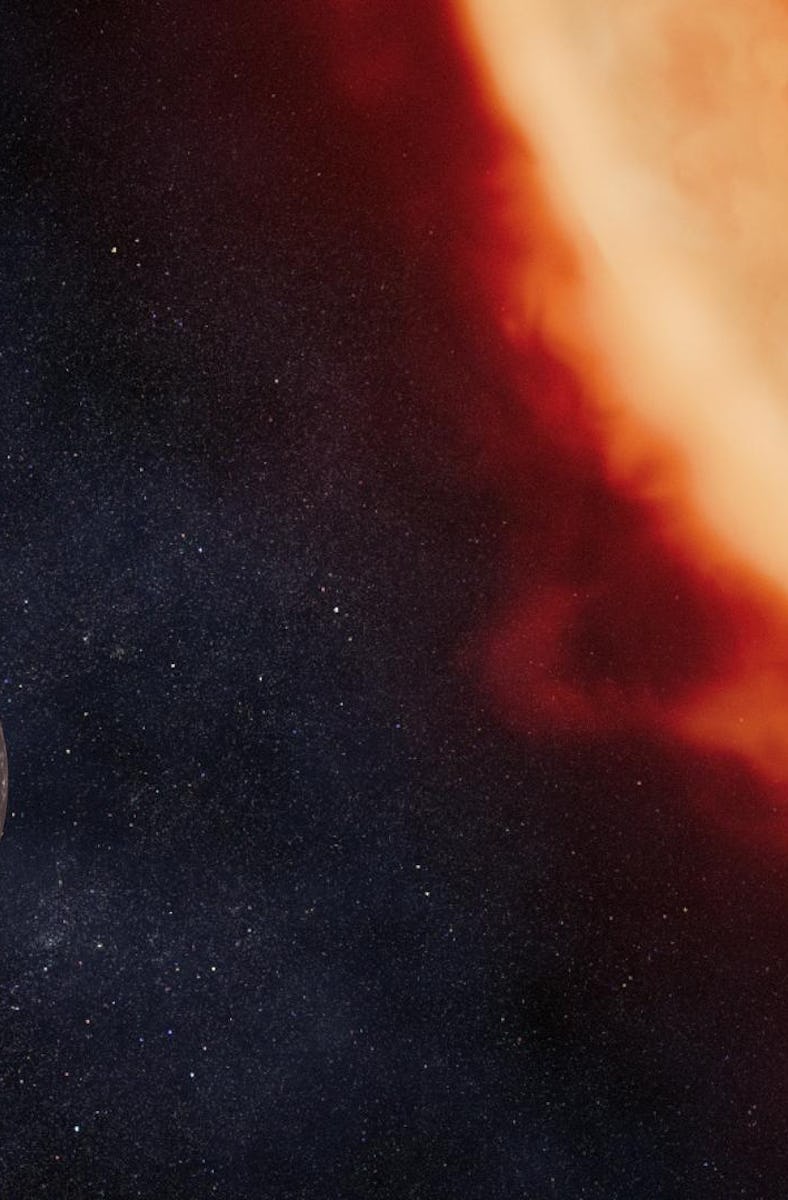How This Tidally Locked Super-Earth Could Help Answer Mysteries in Our Own Solar System
The exoplanet LHS 3844b is warmer than it should be, and figuring out why could help explain some of the weird quirks of our own solar system.

Our Earth is well-suited for life because it is perfectly spit-roasted by our Sun thanks to our planet’s axial rotation — but other planets aren’t so lucky. A new study from Peking University reveals that the weathered super-Earth LHS 3844b, located some 48.5 light years away, is actually tidally locked to its star, meaning one hemisphere is constantly baking under the star’s intense rays while the other freezes in the endless darkness of deep space.
But that’s only the beginning of this strange exoplanetary tale.
According to Peking University planetary scientist Daniel Koll and his colleagues, Spitzer Space Telescope (RIP) measurements of the planet’s surface temperature only make sense if it’s both tidally locked into a perfectly round orbit (that is, rotating at exactly the same speed as it circles its star) and if its surface has been deeply weathered by micrometeorites and stellar winds.
Koll and his colleagues published their work in a pre-print (not yet peer-reviewed or published in a scientific journal) paper.
Synchronous Side Effects
The planetary scientists modeled several orbits and surface environments for the twice-as-massive-as-Earth planet LHS 3844b. In the simulation that best matched the Spitzer data, LHS 3844b is locked into what’s called synchronous rotation, in which the planet rotates once every time it orbits its star. This effectively keeps the same side of the planet in constant daylight, and this type of rotation is actually more unusual than it sounds.
Most planets that orbit so close to their stars are tidally locked but not always in perfectly synchronous rotation. If a planet’s orbit is just slightly more oval-shaped than circular, the same side of the planet would always face the star. But from the surface, the sun would appear to wobble back and forth in the sky, and the planet would feel the constant tug of shifting tides, generating heat in its molten depths. A perfectly circular orbit, on the other hand, means no tides to keep molten rock in motion, and that’s what Koll and his colleagues say is happening on LHS 3844b.
But when Koll’s team ruled out tidal heating, they needed another explanation for why LHS 3844b’s dayside seemed slightly warmer than a bare, star-baked rock should be. Their simulations suggest that the planet absorbs more light and heat from its star because space weathering, which is erosion and chemical changes that happen thanks to micrometeorites and stellar wind, has essentially darkened its surface.
“We're basically just trying to see, in principle, would the space weathering give us a reasonable albedo to make the planet dark enough,” McGill University’s Nicolas Cowan, a co-author of the recent study, tells Inverse.
And that answer seems to be yes.
Judging a Planet By Its Surface
Without the protective blanket of an atmosphere, LHS 3844b’s bare surface catches the brunt of its star’s endless exhalations of charged particles and harsh radiation – not to mention a constant pummeling from tiny bits of space dust. This “space weathering” turns a bright, newly-formed rock into a dark, battered landscape.
Rock gets broken and ground into fine-grained regolith. Heat from all those tiny impacts turns iron in the rock into a weird, melted form called nanophase iron: extremely tiny, dark grains of iron. Without nanophase iron and other effects of space weathering, the Moon's surface would be even brighter than it is now. And micrometeorites, like their larger cousins, tend to contain a lot of carbon, so they drop off things like graphite that darken Mercury’s surface.
“It is the same process that happens in the Solar System,” Cowan says.
And space weathering plays a surprisingly huge role in the planet’s “energy budget,” as Cowan puts it. Without tidal heating, LHS 3844b’s surface temperature depends entirely on how much heat it absorbs from starlight. That, in turn, depends on whether its surface is bright and shiny or dark and dull.
“You want to know how reflective the surface is, and then that will tell you how much energy is being absorbed. So that's where the space weathering comes in,” says Cowan.
Solving an Exoplanetary Mystery
Future observations may tell planetary scientists exactly what makes up LHS 3844b’s surface and how weathered it is. This will help determine if the exoplanet’s regolith contains graphite from micrometeorites or if impacts have created deposits of nanophase iron. That could shed more light not only on LHS 3844b, but on the process of space weathering in our own Solar System, in places like Mercury and the Moon.
In the next few months, the James Webb Space Telescope (JWST) will watch as LHS 3844b orbits its star — especially the moments when it disappears behind the star and then comes back around to reappear on the other side. For those brief moments, the daylit side of the planet will be facing Earth. Astronomers call this a secondary eclipse, and it's the perfect opportunity for JWST's instruments to measure the spectrum of starlight reflecting off the planet's surface. That data will reveal what makes up LHS 3844b and how badly it’s weathered.
Because space weathering tends to darken rock, the starlight that reflects from it will be slightly hotter, giving astronomers stronger signals. On the other hand, space weathering also breaks up crystal structures in the rock, so the spectrum of reflected starlight looks "mushy" instead of sharp, clear lines.
“If we're lucky, maybe the emission spectrum would allow us to actually confirm that there's space-weathered rock,“ Cowan says. “Like you would see some feature that you would expect from a rock, but it would be kind of rounded and mushy, and we would say, ‘Oh, that's because it's been space weathered.’”